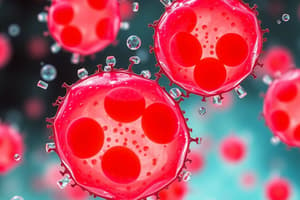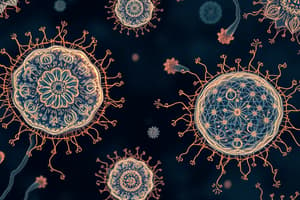Podcast
Questions and Answers
What is the primary distinction between prokaryotic and eukaryotic cells?
What is the primary distinction between prokaryotic and eukaryotic cells?
- Prokaryotic cells contain a membrane-bound nucleus.
- Eukaryotic cells are always unicellular organisms.
- Prokaryotic cells have a circular DNA molecule. (correct)
- Eukaryotic cells lack cytoplasm.
Which structure is unique to plant cells and not found in animal cells?
Which structure is unique to plant cells and not found in animal cells?
- Chloroplast (correct)
- Nucleus
- Cytoplasm
- Cell membrane
In which part of the cell does the majority of cellular activities occur?
In which part of the cell does the majority of cellular activities occur?
- Plasma membrane
- Cytoplasm (correct)
- Cell wall
- Nucleus
What role does the vacuole play in mature plant cells?
What role does the vacuole play in mature plant cells?
Which of the following statements about cell membranes is incorrect?
Which of the following statements about cell membranes is incorrect?
Which microscope type is best suited for observing the internal structures of thinly sliced specimens?
Which microscope type is best suited for observing the internal structures of thinly sliced specimens?
Which of the following is NOT a component of eukaryotic cells?
Which of the following is NOT a component of eukaryotic cells?
Which statement accurately describes the function of mitochondria?
Which statement accurately describes the function of mitochondria?
What is the functional significance of ribosomes within a cell?
What is the functional significance of ribosomes within a cell?
What is the primary purpose of the cell wall in plant cells?
What is the primary purpose of the cell wall in plant cells?
Flashcards are hidden until you start studying
Study Notes
Basic Cell Structure
- Cells are the smallest units capable of independent life, forming all organisms and bodily tissues.
- Eukaryotes possess membrane-bound nuclei within their cells.
- Prokaryotes are characterized by a single circular DNA chromosome.
DNA
- DNA stands for Deoxyribonucleic Acid, which contains genetic information.
Amoeba
- Amoeba is a single-celled organism considered one of the simplest life forms.
Relationship Between Biological Structures
- Similar cells group together to form tissues.
- Tissues collaborate to create organs, establishing a hierarchy of life.
Animal Cell vs Plant Cell
- Animal cells consist of a cell membrane, cytoplasm, and nucleus.
- Plant cells include a cell membrane, cell wall, cytoplasm, nucleus, and a large central vacuole.
Key Components of Cells
- Cell Membrane: Acts as a barrier, separating the cell contents from the external environment.
- Cytoplasm: Site of cellular activities, housing organelles like mitochondria and ribosomes, as well as food reserves (glycogen, starch, oil droplets).
- Nucleus: Contains chromosomes made of DNA, responsible for carrying genetic information.
- Cell Wall: A nonliving external layer present in plant cells, providing structural support.
- Vacuole: In mature plant cells, it contains cell sap, a dilute solution of salts and sugars.
- Chloroplasts: Organelles in plant cells containing chlorophyll, responsible for photosynthesis.
Types of Microscopes
- Stereo Microscope: Provides a three-dimensional view of specimens.
- Compound Microscope: Most commonly used; consists of multiple lenses to magnify objects.
- Polarizing Microscope: Utilized to identify unique optical patterns and phase defects in liquid crystals.
Studying That Suits You
Use AI to generate personalized quizzes and flashcards to suit your learning preferences.




